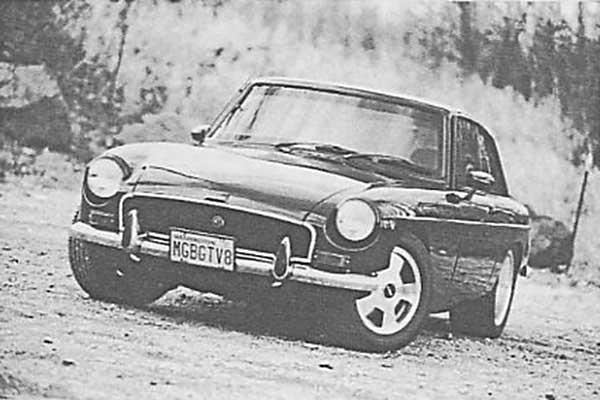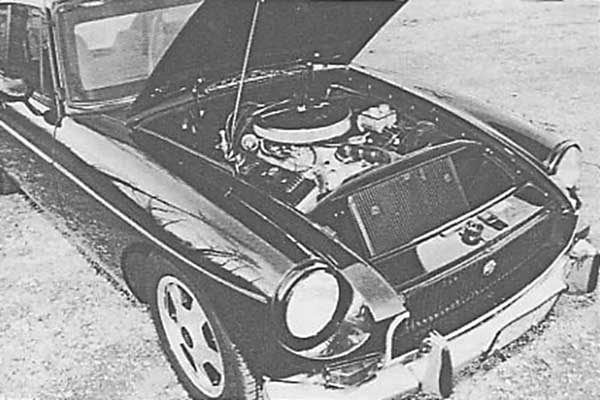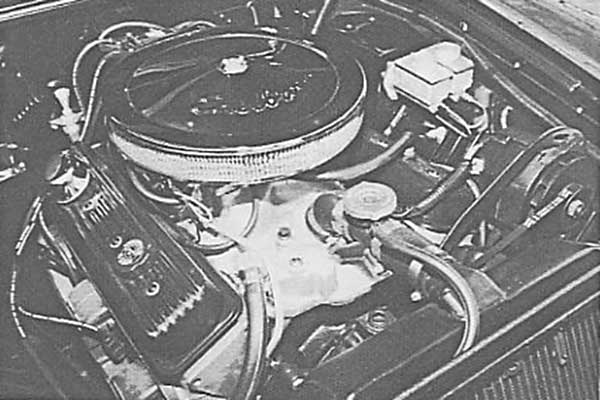�
�
�
�
�
�
�
�
�
�

�
345 H.P. MGB Outruns Porsche Turbo Carreras at Portland International Raceway: Les Anderson's fantastic GT.
�
Les Anderson's 1970 MGB/GT with Chevrolet 350 V8
� ��
by Kurt Schley
�
(originally published in MG-V-8 Newsletter, Volume 4 Issue 1)
�
�
Owner: Les Anderson
�
City: Vancouver, WA
�
Model: 1970 MGB/GT
�
Engine: Chevrolet 350 V8
�
�
| Engine: | �1993 350 H.O. (high output) "crate motor" (ZZ3), 345 HP | �
| Transmission: | �1993 GM TH700R4 automatic, 4 speed + 1 (electric lockup), from Chevy van, � shift kit for crisp 1-2 shift, changed shift point to 5500 rpm under w.o.t., � new driveline with all new u-joints. | �
| Flywheel: | �stock GM flexplate. | �
| Exhaust: | �Sanderson cast-iron headers. | �
| Brakes: | �Rear - Mopar 11" drums. Took some of the braking material off to reduce � over-braking in back. Installed driver-adjustable proportioning valve in � cockpit. Used aftermarket CFC dual master cylinder, non-booster system. � Front discs are stock. | �
| Flywheel: | �stock GM flexplate. | �
| Tires/Wheels: | �wanted 15" wheels/tires with 4.5" bolt circle lugs, so relocated lugs on � Mopar axles to match MG front pattern. Eagle "Hammer Series" 15" x 6" FWD � wheels in front with 195-60R15 tires. Eagle "Hammer Series" 15" x 8" RWD � wheels in back with 225-50R15 tires. | �
| Suspension: | �Moss motors coil-over front suspension with Spax shocks. Converted� rear to Monroe tube shocks. Lowered car approximately 2". | �
| Cooling: | �custom tilted radiator flowed for 350 H.O. motor. One electric cooling fan� mounted behind radiator, thermostatically controlled. Stock short-shaft 350 � Chevy water pump. Cools excellent. | �
| Rear End: | �Mopar 8.75" 3.55:1 narrowed Positraction unit. | �
| Instruments: | �cut out main instrument panel and relocated/installed VDO gauges. Replaced� panel in stock location. Installed "Vintage Air" heating controls for � under-fender heat/defrost. Custom stereo and indicators. | �
�
�
� Parts/Info Sources: all parts obtained from readily available dealers and/or recycle yards.
�
� Conversion recommendations: unless you are determined to make your conversion reflect the original� MGB/GT V8, I recommend the Chevy small block (283-400 c.i.). Spend the money to make the car � correct and safe. I recommend the automatic transmission which avoids dozens of hassles. It works!� Take your time, don't rush. Talk to all involved personnel before you move to the next step; � get several opinions.
�
� Future changes: if the budget allows, I would replace the MG front steering/brake/hub assembly� with an aftermarket unit (JFZ, etc.) properly sized to give better front wheel offset and wheel � choices. Better brakes, suspension, etc. comes with it.
�
� Estimated Cost of Conversion (excluding original car): $25,000 due to labor.
�
�
� I have built several MG conversions, utilizing the traditional 215 Buick, a 3.8L Buick V6, a � Mazda rotary, and now the 350 High Output Chevrolet. This latest one was built with one goal in � mind: since this was to be my personal car, it had to be the best of everything with the finest � craftsmanship that I could buy. After spending considerable time designing the project, I decided � that the air conditioning and electric windows would be overkill, so these were removed from the� list. We would spare no expense to make the car fast, predictable, clean, and above all - safe to � drive at any reasonable speed. It also had to pass our local DEQ requirements.
�
� The High Output 350 Chevy motor was selected for several reasons: I had resisted this motor � for several years simply because "everyone uses them and I want to be different." However, � I now know why everyone uses this motor. It has unlimited horsepower potential, parts are available� anywhere in the world, costs for parts are a fraction of everything else, and it is dimensionally � only slightly larger than the 215 Buick/Rover V8. Everyone will immediately ask, "What did you � do to overcome the huge weight increase?" Not to worry... This motor has a large amount of � aluminum components and weighs less than 100 pounds more than the MGB motor it replaces. This, � combined with the setback achieved with the removal of the heater assembly gives the driver the � feel that it is the same as the MGB in terms of weight distribution, and the horsepower gains� are............... well, I'm sure you can imagine!
�
� I recommend the ZZ3 motor (350 High Output "Crate" motor) that you can buy from any Chevrolet � dealer in your town. I wrote a check ($2612.50) for mine in Portland Oregon. This is an awesome � motor. It is not available in any vehicle, but is manufactured by Chevrolet for the aftermarket � enthusiast who doesn't want to build his own motor, but does want high horsepower (345) in a � factory built motor that has all the normal hot-rodding tricks done to it and comes with a � WARRANTY. The motor is nearly complete when you take it home in your pickup truck. IT has a new � HEI ignition, the Corvette aluminum heads, steel crank, "pink" rods, high performance cam, special� pistons, plugs are installed, aluminum intake manifold, and has a test-run tag attached. It is � even full of oil! All you do is add a carburetor of your choice, a fan if you're going to use one,� a set of exhaust manifolds to suit your installation and fire it up.
�
�
�
�
�

�
�
� Parts/Info Sources: all parts obtained from readily available dealers and/or recycle yards.
�
� Conversion recommendations: unless you are determined to make your conversion reflect the original� MGB/GT V8, I recommend the Chevy small block (283-400 c.i.). Spend the money to make the car � correct and safe. I recommend the automatic transmission which avoids dozens of hassles. It works!� Take your time, don't rush. Talk to all involved personnel before you move to the next step; � get several opinions.
�
� Future changes: if the budget allows, I would replace the MG front steering/brake/hub assembly� with an aftermarket unit (JFZ, etc.) properly sized to give better front wheel offset and wheel � choices. Better brakes, suspension, etc. comes with it.
�
� Estimated Cost of Conversion (excluding original car): $25,000 due to labor.
�
�

�
�
� I have built several MG conversions, utilizing the traditional 215 Buick, a 3.8L Buick V6, a � Mazda rotary, and now the 350 High Output Chevrolet. This latest one was built with one goal in � mind: since this was to be my personal car, it had to be the best of everything with the finest � craftsmanship that I could buy. After spending considerable time designing the project, I decided � that the air conditioning and electric windows would be overkill, so these were removed from the� list. We would spare no expense to make the car fast, predictable, clean, and above all - safe to � drive at any reasonable speed. It also had to pass our local DEQ requirements.
�
� The High Output 350 Chevy motor was selected for several reasons: I had resisted this motor � for several years simply because "everyone uses them and I want to be different." However, � I now know why everyone uses this motor. It has unlimited horsepower potential, parts are available� anywhere in the world, costs for parts are a fraction of everything else, and it is dimensionally � only slightly larger than the 215 Buick/Rover V8. Everyone will immediately ask, "What did you � do to overcome the huge weight increase?" Not to worry... This motor has a large amount of � aluminum components and weighs less than 100 pounds more than the MGB motor it replaces. This, � combined with the setback achieved with the removal of the heater assembly gives the driver the � feel that it is the same as the MGB in terms of weight distribution, and the horsepower gains� are............... well, I'm sure you can imagine!
�
� I recommend the ZZ3 motor (350 High Output "Crate" motor) that you can buy from any Chevrolet � dealer in your town. I wrote a check ($2612.50) for mine in Portland Oregon. This is an awesome � motor. It is not available in any vehicle, but is manufactured by Chevrolet for the aftermarket � enthusiast who doesn't want to build his own motor, but does want high horsepower (345) in a � factory built motor that has all the normal hot-rodding tricks done to it and comes with a � WARRANTY. The motor is nearly complete when you take it home in your pickup truck. IT has a new � HEI ignition, the Corvette aluminum heads, steel crank, "pink" rods, high performance cam, special� pistons, plugs are installed, aluminum intake manifold, and has a test-run tag attached. It is � even full of oil! All you do is add a carburetor of your choice, a fan if you're going to use one,� a set of exhaust manifolds to suit your installation and fire it up.
�
�
�
As you can see from the pictures, the motor looks as if it were born there. The obvious question �
which inevitably comes up is: "How does it all work?" Let me say this. Of all the cars I have �
put together, this is the one that gets my juices going every time I step into it, even if it is �
only to go to the grocery store. The way it looks, the way it sounds, and the overall impression �
it gives causes people of all ages and genders to stop me wherever I go to tell me what a �
beautiful ride it is and "Could you please lift the hood for me?" and then comes the... "Oh my �
God, look at that thing! That thing must absolutely fly!" And I say: "Well, yes, it does."
�
� To put it into perspective from a performance standpoint, I have not run it through the quarter � mile, however I am certain that it is somewhere in the 13 second range and could probably do better � with a set of slicks. Top speed is well out of my range of willingness to go that fast. I would � estimate around 150 or more, however I would not recommend trying it due to aerodynamic problems. � Handling is superb and it is a very reliable car. I have had no problems with it whatsoever, other � than my Summit Racing mini-starter failed, but they covered it under warranty. (It was defective.)
�
� I did have an unusual opportunity this last weekend to attend the Alpha Romeo Track Day at Portland� International Raceway. I was allowed to run it around the 1.9 mile racetrack. You first go around at � reduced speed with a professional driver monitoring your abilities, and then slowly you move up the � ranks and are allowed to run on your own and/or with other cars of various styles and performance. � My thrill was to run with about 25 other cars at the end of the day at full speeds, although for � safety, passing was only allowed in the corners. What a thrill!!!! I was dicing it up with the � killer Porsches, Alphas, Corvettes, and everything else you could think of, all at the same time.� To my surprise, I could keep up with and in some cases pass the Porsche Turbo Carreras. They would � get me in the corners, but I had the torque and acceleration to spare. In fact this car wants to � run so hard that I found that it shifted INTO OVERDRIVE at above 110 mph and then wanted to run � harder, but I chickened out because I saw the first turn coming at me extremely fast. On one run� I had a friend videotaping the whole event from inside the car, capturing the sounds and sights � of running at high speed. Can't wait to get my copy of the tape!
�
� Well, I could babble on about this car forever. The message I want to leave your readers with is � that the 350 Chevy option is probably little or no more expensive than the higher output 215 option, � and you end up with a more reliable car with gobs more performance. The parts are a lot less � expensive and more readily available and the car is an unending kick in the pants to drive, even � with the automatic transmission. A Borg Warner 5 or 6 speed would be great also.
�
� Before I close, I want to give special accolades to my design and building partners at Time Machines� Northwest in Vancouver, WA (phone: 360-573-2457) for their outstanding job in preparing this car.� Jan Waird and Len Darnell are perfectionists and it is tribute to their craftsmanship that I have � had no problems with this car and it has been on the road for two years. Should any of your readers� have the capability to provide the basic car (GT or roadster), I would suggest Time Machines NW as the � place to have it converted, even with the labor and the shipping costs, as the end products will be � worth the extra expense. If interested, readers may call them direct, or you may contact me at MGB-PLUS� (8408 NW 15th Court, Vancouver, WA 98665). Best of luck to all of your V8 conversion enthusiasts!� Once you get the bug, it never goes away. Build it and enjoy it! � �
�
� Copyright: 1996 (text and photos). All rights reserved.
� Use by written permission from "britishv8.org" only. �
�
�
�
� To put it into perspective from a performance standpoint, I have not run it through the quarter � mile, however I am certain that it is somewhere in the 13 second range and could probably do better � with a set of slicks. Top speed is well out of my range of willingness to go that fast. I would � estimate around 150 or more, however I would not recommend trying it due to aerodynamic problems. � Handling is superb and it is a very reliable car. I have had no problems with it whatsoever, other � than my Summit Racing mini-starter failed, but they covered it under warranty. (It was defective.)
�
� I did have an unusual opportunity this last weekend to attend the Alpha Romeo Track Day at Portland� International Raceway. I was allowed to run it around the 1.9 mile racetrack. You first go around at � reduced speed with a professional driver monitoring your abilities, and then slowly you move up the � ranks and are allowed to run on your own and/or with other cars of various styles and performance. � My thrill was to run with about 25 other cars at the end of the day at full speeds, although for � safety, passing was only allowed in the corners. What a thrill!!!! I was dicing it up with the � killer Porsches, Alphas, Corvettes, and everything else you could think of, all at the same time.� To my surprise, I could keep up with and in some cases pass the Porsche Turbo Carreras. They would � get me in the corners, but I had the torque and acceleration to spare. In fact this car wants to � run so hard that I found that it shifted INTO OVERDRIVE at above 110 mph and then wanted to run � harder, but I chickened out because I saw the first turn coming at me extremely fast. On one run� I had a friend videotaping the whole event from inside the car, capturing the sounds and sights � of running at high speed. Can't wait to get my copy of the tape!
�
� Well, I could babble on about this car forever. The message I want to leave your readers with is � that the 350 Chevy option is probably little or no more expensive than the higher output 215 option, � and you end up with a more reliable car with gobs more performance. The parts are a lot less � expensive and more readily available and the car is an unending kick in the pants to drive, even � with the automatic transmission. A Borg Warner 5 or 6 speed would be great also.
�
� Before I close, I want to give special accolades to my design and building partners at Time Machines� Northwest in Vancouver, WA (phone: 360-573-2457) for their outstanding job in preparing this car.� Jan Waird and Len Darnell are perfectionists and it is tribute to their craftsmanship that I have � had no problems with this car and it has been on the road for two years. Should any of your readers� have the capability to provide the basic car (GT or roadster), I would suggest Time Machines NW as the � place to have it converted, even with the labor and the shipping costs, as the end products will be � worth the extra expense. If interested, readers may call them direct, or you may contact me at MGB-PLUS� (8408 NW 15th Court, Vancouver, WA 98665). Best of luck to all of your V8 conversion enthusiasts!� Once you get the bug, it never goes away. Build it and enjoy it! � �
�
� Copyright: 1996 (text and photos). All rights reserved.
� Use by written permission from "britishv8.org" only. �

